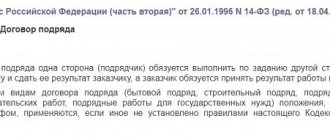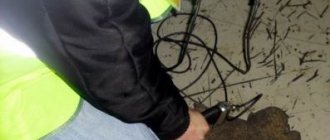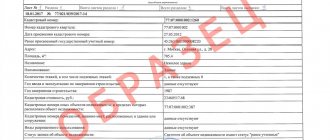- Obvious, detected breakdowns. Their presence does not require additional evidence. Example: a crack or deformation of a certain part. A detailed description of the breakdown and the probable causes of its occurrence are given. It is advisable to add an image of the breakdown in the applications.
Potential defects. A group that is more difficult to detect. Here are the breakdowns that can occur if repairs are not carried out. Example: worn out machine transmission belt. He is still able to work. But without a quick replacement, it will certainly fail. This paragraph lists each potential defect, as well as the reasons for its occurrence.
The number of copies of the act drawn up depends on who is doing the repairs. When a company repairs an object on its own, you can make one copy.
If she involves a contractor, she needs to draw up at least two copies (one for herself and one for the contractor). The document is signed by representatives from the customer and contractor.
A missing or incorrectly drawn up defective act often becomes the reason for the tax inspectorate not to recognize the costs of repairing (writing off) OS (equipment) in tax accounting, which leads to additional taxes and penalties.
The result of the inspection is the drawing up of an act. The document for write-off can be drawn up in any form. If the company has a template established by order, the act is drawn up according to its model. The work uses generally accepted samples or the OS-16 recommendation template.
Federal Law No. 402 “On Accounting”. Otherwise, the document is not accepted by the tax office.
The defect report indicates not only the defects that were discovered during the inspection of the building, but also their quantitative characteristics. It should be noted that cost indicators are not recorded in the act.
Depending on the number of interested parties, it is necessary to issue an appropriate number of copies.
Source: https://hermes-sale.ru/konsultaciya/13943-defektnyy-akt-obrazec-kazakhstan-skachat-besplatno.html
How to draw up a defect report for current repairs? Sample filling
The defective act for current restoration refers to the original accounting document.
It is filled out by the institution whose balance sheet includes the objects being inspected. An act of a special commission is drawn up in accordance with generally accepted standards (SNiP, ROST and GOST). This document is the basis for calculating the estimated cost of the object. In what cases is it compiled?
A defective repair report is issued only when defects are detected in the objects under study. These include buildings and structures, vehicles, as well as any type of equipment. Various institutions carrying out commercial activities have the right to draw up such a document, regardless of their affiliation with the sector of the national economy. Most often, drawing up a list of defects for restoration is found in construction institutions and in production.
Defective act for repair of premises: example
Free consultation by phone Contents A defect sheet for repairs of premises is a document justifying the organization’s expenses for repair work, consisting of a generalized table containing a list of defects, consumables, scope of work, final conclusions, recommendations for elimination and other similar information.
There are two main points of view and functionality on it:
- Tax accounting and taxation - this is where the economic justification for the feasibility of repair work takes place. Also, with the help of a defective statement, an understanding of the repair situation comes - whether it is ordinary repair work or modernization (reconstruction) of fixed assets, since they have different cost divisions according to criteria. Also, this document is a confirmation to the tax office as a rational expenditure of the enterprise’s funds for the above work.
- Material assets - determination of their total volume, taking into account defects and the general plan, analytics on repair work and the situations that led to them, recommendations for preventing such situations in the future.
Recommended reading: Developing Mindfulness for Lawyers
Important! A defective statement is a fundamental document when drawing up a local estimate, so equate and use it as a primary accounting document. It is worth understanding the difference between a defective statement and a defective act.
Basically, this document has an exculpatory function and contains data for analyzing the situation and conducting further operations of the economic plan.
Defective Act We, the undersigned, have drawn up this act stating that during major repairs it is necessary to carry out work in the following volumes:
1 APPROVED Head of Kindergarten 155 of JSC Russian Railways / / 2014
pp Name of work Repair of premises of group 1; Ceiling Single Meas. Quantity 1 Removal of suspended ceilings m2 129.5 2 Continuous leveling of ceilings with a dry mortar mixture of thickness. 10mm. for subsequent painting of ceilings m2 129.5 3 Rotband plaster mixture 112.7 * 1.5 kg. 205 Putty on plaster ceilings prepared 4 for painting m2 129.5 5 Coating surfaces with a primer at a time m2 129.5 6 Primer "Betokontakt" 112.7 * 0.12 kg.
17.2 7 Improved water-based paint on ceiling plaster m2 129.5 Walls 8 Removing wallpaper from the surface of walls m2 149.3 9 Coating walls with antiseptic m2 149.3 10 Continuous leveling of walls with dry mortar mixture "Rotband" m2 149.3 11 Putty plastering walls prepared for painting m2 149.3 12 Priming wall surfaces in one go m2 149.3 13 Applying a non-flammable decorative water-based coating to the wall surfaces m2 149.3 14 Coating wall decor with varnish m2 149.3 15 Loading operations tn Delivery waste up to 15 km tn 0.05 Repair of premises of group 2 Ceiling 17 Removal of suspended ceilings m2 130.6 18 Continuous leveling of ceilings with dry mortar mixture "Rotband" m2 130.6 19 Putty on plaster ceilings prepared for painting m2 130.6 20 Coating surfaces primed at a time m2 130.6 Improved water-based painting
How to draw up a defect report in 2021
The report of defects for restoration activities can be drawn up in either a free or standard form. Some institutions themselves develop this document containing the necessary columns and tables. Only members of the commission appointed by order of the management of the institution have the right to fill out the form. The commission begins its work after familiarizing itself with the order. The task of the commission is to scrupulously inspect objects for malfunctions and defects. When inspecting a construction site, commission specialists are required to inspect structural elements, the functionality of which must comply with standard rules and state regulations, taking into account the percentage depreciation of fixed assets.
If defects are discovered during the inspection period, members of the commission fill out a report with the identified information. Based on the list of defects, an estimate is drawn up and repairs of the facility are carried out. You can add photographic materials to the report, as well as comments from witnesses.
At the end of the form, the commission members are required to write their conclusions on the current position of the object. As a rule, such a document contains tables for entering all identified comments. The act, in its external state, is similar to an estimate without the content of estimated indicators.
For a more complete justification of the need for routine repairs or overhauls, the document compiled must display the following information:
- The name of the street and address of the house where repairs are planned.
- Stages of repair.
- List of elements required for restoration.
- List of all comments found during research, etc.
defective statement
Content
The defect report is filled out by the institution on A4 sheets, with the mandatory content of the following data:
- The family list of members of the appointed commission.
- The name of the institution where the examination is performed.
- Name of the object under study with display of technical information, incl. inventory number.
- List of detected comments.
- Recommendations of commission members for major repairs or ongoing restoration, etc.
In order for the paper to acquire legal validity, it must be signed by all members of the commission and certified by the seal of the institution where the site was examined.
Often the need to write a defect report arises among entrepreneurs who are preparing their production workshops or office buildings for repairs. In this situation, a commission is created from highly qualified specialists, which assists in calculating the total amount of costs necessary to eliminate the identified defects. After approval of the report of defects by the members of the commission, an estimate is created in which the costs of upcoming restoration activities are calculated.
Sample of the final part of the defective statement
Defective Act – Sample and Form 2020
The organization that owns the machinery, equipment and other fixed assets periodically inspects them for breakdowns. If any deficiencies are discovered, a defect report is issued.
It is necessary in order to officially record defects existing on the property of the enterprise. First, the manager issues an appropriate order, which is considered the basis for creating an inspection group.
As a rule, this commission includes company specialists from different departments.
Why is a defective act needed?
After specialists identify defects, they are entered into a special table in the document. The commission must then make a collective decision on whether it is possible to eliminate the detected defects.
If the equipment cannot be repaired, or fixing the problems exceeds the cost of new equipment, it is written off. Such actions are carried out precisely after the registration of a defective act. It is in this document that the relevant conclusions of the commission members are indicated.
If the property is subject to restoration, this must also be indicated in the act. In this situation, the organization allocates the necessary amount to eliminate faults.
It must be remembered that the act refers to accounting documentation, the correct completion of which is checked by the tax service. If the act is filled out incorrectly, it will be considered that an error was made in the tax accounting of the enterprise. Indeed, in this case, tax officials recognize the write-off of property or the allocation of money for its repair as unlawful. As a rule, this results in a fine.
How to draw up a defective act
The law does not oblige companies to adhere to strict standards when filling out this document. Since there is no unified form, the act can be drawn up in free form.
Practice also shows that many companies use an internal template designed specifically for these purposes to draw up a defect report.
Instead of a letterhead, you are allowed to use a sheet of A4 paper.
Since the document is intended to indicate all identified faults, most of it is occupied by a table. If the act is drawn up not according to some template, but by hand, it can be drawn up in the form of a list. In any case, detailed information about breakdowns and repair options should be indicated here.
The document must include the following information:
- number and date of the order that became the basis for the inventory;
- information about the company is indicated in the corresponding column. If it has different divisions, the one in which the inspection is carried out is noted;
- details of the company director;
- exact definition of the investigated object or name of the equipment;
- the date of inspection is noted;
- name of the document and its number assigned by internal document flow;
- a list of specialists who conduct inventory;
- Full names and positions of the chairmen of the commission;
- detailed description of detected faults;
- conclusions of specialists about write-off or troubleshooting.
Many people mistakenly believe that the act must indicate the cost of the inspected objects or equipment. Supposedly this will help determine the feasibility of expensive repairs. However, no prices are indicated here.
To convey the essence of the malfunction as accurately as possible, it is recommended to carefully consider the wording. This rule should also be used when drawing up repair recommendations.
If an object cannot be restored, it is necessary to correctly and clearly explain why it should be written off. All information written in the act must be confirmed by the signatures of each member of the inspection commission.
Each expert signs next to his last name and deciphers it.
Once completed, this document becomes the basis for approval of the list of all necessary repairs. After determining the estimated cost, the object begins to be restored.
Sometimes you may encounter a situation where a manager or other person holding a high position considers expert opinions to be incorrect.
At the same time, he can appeal the decision and prove his case only through the court.
Defective report for current repairs
Regardless of what kind of activity the organization conducts, it has the right to draw up a defect report for current repairs. The document is drawn up if any malfunctions are detected at the objects under study.
This can be not only buildings, but also equipment, various vehicles, and any types of structures. A specially created commission, having identified all existing defects, determines whether the object needs cosmetic repairs or major repairs.
The appearance of the document has some similarities with the estimate, but there are no prices. But with the help of the act, an estimate for current repairs is drawn up.
The document is drawn up by the customer, who must clearly state the list of works, their features and other characteristics. Also here you need to accurately indicate the measurement measures that comply with the standards.
Sample defect report for current repairs
Defective act for construction work
The purpose of this type of act is to identify shortcomings during construction. It is worth noting that, at the request of the customer, the inspection can be arranged at any stage of construction.
Thus, if there are defects, experts determine the scale of the inaccuracies and who is responsible for their occurrence. In addition, customers are often faced with a situation where the contractor requires additional financing.
With the help of this act, specialists will be able to refute or confirm such a need.
It is also worth noting that on the basis of the report on defects during construction work, other documents are drawn up, an estimate, a certificate of completion of construction work, write-off of materials, etc.
We can say that without this act the contractor cannot complete construction work. As with the preparation of any defective act, the manager must form a commission.
Its senior member should be an experienced construction specialist.
Defective equipment repair report
Repair of equipment on the organization’s balance sheet begins only after the relevant report has been drawn up. Many draw up this document using the OS-16 form. Although this is not a requirement. Like other defective acts, it can be drawn up in free form. The main thing here is the availability of all the necessary information about the identified defects and the signatures of the responsible persons.
To draw up this act, a specially created commission has to disassemble the equipment being examined. This is due to the fact that specialists must carefully examine all the parts, even those that are hidden far away. It is through disassembling the equipment that the commission will be able to identify hidden defects and malfunctions.
Every technical device needs periodic inspection. This allows the organization’s management to have information that describes in detail the technical condition and serviceability of the equipment.
With the help of this act, the manager will be able to determine the volume of upcoming repair work and their cost. Thus, it is possible to objectively assess whether the organization is ready to allocate the required amount.
If the company has such finances, restoration work begins immediately. Otherwise, the repairs are postponed and the search for investors begins.
Sample of a defect report for equipment repair
Sample of filling out a defect report for current repairs
The report of defects for current restoration is a document reflecting the defects and shortcomings discovered during the examination of the object by the appointed commission. This document can be drawn up under the following conditions:
- During a routine inspection of the facility.
- When examining an object due to a disruption in its normal operation.
- When accepting an object from repair, after installation work, when putting the object into operation.
This form is the basis for:
- Carrying out repair and restoration activities.
- Write-off of costs incurred during the performance of these works.
- Write-off of an object if it is impossible to restore it.
The act is a continuous table in which detected defects are recorded, without displaying the cost of upcoming costs. The purpose of this document is to confirm the actual condition of the facility to identify the scale of upcoming repairs and its feasibility. And based on the act, the following is subsequently drawn up:
- Repair estimate
- Report on the feasibility of repair work.
- An order to carry out repairs or to write off an object.
Defective act on wallpapering
10.6 Dismantling wall cladding with decorative fiberboard 24 m2 10.7 Preparing walls for wallpapering with non-woven backing (priming, puttying 41 m2 10.8 Pasting walls with wallpaper on non-woven backing 41 m2 11. Cabinet No. 000 11.1 Dismantling decorative panels made of fiberboard 20 m2 11 .2 Dismantling linoleum 12 m2 11.3 Dismantling wooden plinth 13 m2 11.4 Clearing whitewash walls 18 m2 11.5 Wallpapering walls with preparation 38 m2 11.6 Improved water-based painting of ceiling 12 m2 11.7 Repairing seam on ceiling 6.7 m2 11.8 Oil painting of windows with clearing 2.4 x 1 .75 m 4.2 m2 11.9 Glass replacement 1.4 m2 11.10 Installation of door DG 21-9, cashing 1.9 m2 11.11 Plastering walls 2 m2 11.12 Plastering door slopes 2 m2 11.13 Oil painting of door and window slopes 3.5 m2 11.14 Oil painting of pipes and radiators 3 m2 11. 15 Oil painting of a metal box 1.2 m2 11.16 Leveling device thick cement screed. He certifies the “defect” with his signature, thereby fixing his responsibility to his own superiors, the owner of the car, and the tax inspectorate.
When is it compiled? The preparation of a defective list can be caused by one of the following reasons: economic - the need to record defects and plan the necessary actions for repair (modernization) and prevention; tax - based on the statement, the effectiveness of investments in repairs and write-off of related expenses is calculated, which is strictly controlled by the tax authorities; clarifying - this document is decisive in establishing the type of work required (repair, modernization, improvement, restoration), and therefore their price category.
Sample defect report for major repairs
An act of major repairs is drawn up when any defects in structural or structural elements are discovered at the objects being inspected. Most often, such restoration statements are compiled by construction companies, which have many objects, equipment and other types of equipment on their balance sheets.
The capital restoration act can be filled out either in a free form or in a unified form approved by the standards of the Russian Federation. Thus, by Decree of the State Statistics Committee of the Russian Federation No. 7 dated January 21, 2003, standard form No. OS16 was approved, which is often used when inspecting objects.
Only members of the commission appointed by the heads of the institutions on whose balance sheet the objects are located have the right to fill out this form. Specialists have the right to begin examining the object only after familiarizing themselves with the order of the manager. The commission carefully examines emergency fixed assets. If faults are identified in structures or elements of the facility, the commission is obliged to display the identified comments in the statement. At the end of the inspection, members of the commission are required to provide conclusions on the condition of the inspected object and a conclusion on the implementation of major repairs or ongoing restoration. The list for major repairs consists of a table in which information about all comments is entered. In terms of content, the defective statement for major repairs is no different from the report for current restoration.
Defective act for write-off of partial wallpapering in the office
For example, at the initial stage, such acts can be used in workshops where there are the highest costs for equipment repairs. At the same time, you should not use a defect report for absolutely all existing equipment.
For low-value property, less labor-intensive and time-consuming methods of repair and write-off can be used. What is it? An act is a document that confirms any accomplished fact. The defect report is confirmation of the identification of defects.
It also contains recommendations for troubleshooting. An act is drawn up based on the conclusion of a commission of experts. Externally, the act is a table in which problem areas of the inspected object are indicated.
Although the form of the act can be developed by the organization independently. The defective act does not reflect the cost of future expenses.
Defective act. sample filling
What are the features of creating a defective act? Write-off of equipment and fixed assets in production or repairs require documentary justification.
- Basic Aspects
- Emerging nuances
It is necessary to indicate the reasons for the malfunction or impossibility of use, that is, defects of the object. For this purpose, a defective act is created.
What are the features of its composition? A defect report is drawn up upon inspection of damage and malfunctions of the object.
The document becomes the basis for complete or restorative repair or write-off. The act is drawn up by a special commission approved by order of the head.
Possible defects when gluing wallpaper, ways to eliminate them
defective act for repair of fixed assets Typical and recommended forms of defective act Recommended forms of defective act for write-off (repair) of OS (equipment) download on our website:
- Defective report for repair of fixed assets (equipment)
Download the defective report for the repair of fixed assets
- Defective act on write-off of fixed assets (equipment)
Download the defective act for write-off of fixed assets The standard form of form No. OS-16 is available for download in the article “Unified form No. OS-16 - form and sample.” Results The defect report refers to one of the primary documents justifying the need to repair (write off) the operating system (equipment).
Organizations use its unified form No. OS-16 or an independently developed form.
We draw up a correct defect report - sample
The commission for identifying defects includes: Representatives of the department that operates the object of inspection - they sign the report. They initiate repairs, are the first to identify malfunctions and are most interested in eliminating defects Repair service representatives Fill out a report.
Their task is to restore the object and, therefore, they can inspect the object in detail and establish the scope of necessary work Persons who accept equipment or OS from repair - control the process Specialists in economic issues and accounting Analyze costs, generate reports The defective act must contain the details of the primary documentation.
Blanker.ru
A defect report is drawn up based on the results of an inspection of damage found on the object under investigation. The act is fundamental for carrying out restoration work. Attention: A report on defects discovered at the site is drawn up after inspection by a special expert commission.
When drawing up a report on identified defects, similar to a defect sheet, a list of identified deficiencies and defects in the inspected object is compiled.
Important Based on the report on the identified defects of the object, the commission members make a decision to carry out restorative repairs of the identified defects and deviations in order to eliminate them or to overhaul the entire object.
A list of parts that need to be replaced and work that needs to be performed is listed. Finally, the estimated cost for this list of works and materials is given.
Features of drawing up a defective act
If you do not close the windows, then such defects may arise from a draft, and in this case it will not be possible to eliminate them. 2. Gaps in joints are a problem with uneven walls. The gaps in the joints represent wider areas of the joints, i.e.
That is, there is a gap between the canvases, sometimes so large that the wall is visible through it.
It is possible to eliminate such a defect, but it is extremely difficult: to do this, you need to pull the edges with a wallpaper spatula towards the center of the joint, using great physical force. You should start moving approximately 5 cm from the joint.
At the same time, you still need to try not to damage the wallpaper pattern, which is even more difficult. Before stretching the joint, you need to inject glue under both sheets at the defect site, wait a little for them to become saturated, and then begin to act. 3.
What kosgu code is used to reflect the purchase and installation of wallpaper in an institution?
The act is always drawn up by an authorized expert commission, which should include representatives of all interested organizations. Based on the results of the inspection, conclusions and an expert opinion are drawn, which are also entered into the report.
Based on them, estimates for repair work or write-off acts are then drawn up. Therefore, it is very important to follow the procedure for drawing up a defect report and draw it up correctly. Today we will look in detail at how to draw up a defective act, what rules exist when filling out a standard form, what alternative forms are used and how the procedure for drawing up such an act occurs.
1 area of use
This form is actively used in a variety of industries to record equipment defects. Form OS-16 was approved by Resolution of the State Statistics Committee of the Russian Federation No. 7 of January 21, 2003. The full name of the document is “Act on Identified Equipment Defects.”
But the content of this form is in no way universal and in some cases the use of OS-16 is unacceptable. For example, such a document cannot be used to identify defects in real estate.
In this case, the organization approves its own form of the act, taking into account the legal requirements for registration. To replace doors As usual, defects in property objects are identified during installation or operation.
Drawing up a defect report for replacing doors can have various consequences, which depends on the inspection period. Here we should consider the different types of defects.
Wait a little until the wallpaper is soaked at the injection site, squeeze out excess glue and carefully smooth the surface, wipe it with a dry and soft cloth. 6. Folds in the area of the inner corner result from the fact that the angle is different from 90°, and therefore the canvas “becomes” uneven in it.
Source: https://agnbotulinum.com/defektnyj-akt-na-spisanie-chastichnoj-poklejke-oboev-v-kabinete/
Defective act. Sample filling
A defect report is a special accounting document that records shortcomings, breakdowns, defects of equipment and technology. It refers to primary documentation and is drawn up on the basis of the conclusions of a commission of experts. The commission is appointed by the management of the organization, which conducts an inventory check of its property and most often includes employees of the enterprise from different structural divisions. Typically, companies that have a lot of different types of equipment, machinery and other fixed assets on their balance sheets resort to drawing up this document. The basis for the work of the expert commission is an order issued by the director of the enterprise.
Defective act for write-off of materials
Any material assets that are registered with the company are subject to mandatory accounting.
Even if for some reason they have become unusable, they must be properly written off. In such situations, a defect report is drawn up, intended for writing off materials. As expected, a commission is created to draw up the act. It should include persons financially responsible for the materials being written off, for example, a storekeeper. It is necessary to understand that there must be good reasons for writing off material assets. Therefore, additional documentation is often used here to confirm the fact that the materials have actually become unusable. Unlike other defective acts, the document intended for write-off contains specific amounts. So, the table here indicates the names of materials, their quantity and the cost of each unit. At the bottom of the document the total cost of materials to be written off is indicated.
The act is filled out in one copy, which is intended for accounting employees. However, financially responsible persons who are members of the commission have the right to receive copies of the document. Accounting calculates the loss that the organization incurred due to the loss of these materials. Naturally, this information is also shown in tax accounting.
Sample of a defective act for write-off of materials
Source
Why is a defective act needed?
A defective act is the basis for a decision to write off fixed assets. During the inventory, when deficiencies are identified, the expert commission enters information about them into a special table, and also draws conclusions about the possibility or impossibility of eliminating them. If the defects cannot be corrected, then a decision is made to write off the equipment.
If a defective act is drawn up incorrectly, this may result in a refusal by the tax service to recognize the costs of repairs or write-off of fixed assets in the tax accounting of the enterprise.
This, in turn, will lead to an increase (additional charge) of tax payments and at the same time a fine.
Defective act on wallpapering
» Financial law For example, at the initial stage, such acts can be used in workshops where there are the highest costs for equipment repairs.
At the same time, you should not use a defect report for absolutely all existing equipment.
For low-value property, less labor-intensive and time-consuming methods of repair and write-off can be used. What is it? An act is a document that confirms any accomplished fact. The defect report is confirmation of the identification of defects.
It also contains recommendations for troubleshooting. An act is drawn up based on the conclusion of a commission of experts.
Externally, the act is a table in which problem areas of the inspected object are indicated. Although the form of the act can be developed by the organization independently. The defective act does not reflect the cost of future expenses. What are the features of creating a defective act? Write-off of equipment and fixed assets in production or repairs require documentary justification.
- Basic Aspects
- Emerging nuances
It is necessary to indicate the reasons for the malfunction or impossibility of use, that is, defects of the object.
For this purpose, a defective act is created.
What are the features of its composition?
A defect report is drawn up upon inspection of damage and malfunctions of the object.
The document becomes the basis for complete or restorative repair or write-off. The act is drawn up by a special commission approved by order of the head.
How to draw up a defective act
There is no unified standard form for a defect report, so organizations can write it either in free form or using a specially developed internal template. Typically this document looks like a table or a list that includes all the information about the identified defects and the likelihood of correcting them. If an organization draws up a document independently, then it can draw it up either on letterhead or on a regular A4 sheet. In this case, the act must necessarily contain the following:
- name of the company and information about the manager;
- the exact name of the equipment or object for which the inventory check is being carried out;
- list of officials included in the expert commission;
- information about the defects found;
- recommendations for eliminating breakdowns and defects.
The act is drawn up in the number of copies necessary for all interested parties, and each of them must be certified by an expert commission. No prices or cost of equipment are indicated in the act.
Sample of a defective wallpaper painting report
Correction is only possible by re-gluing the wallpaper; – tearing the wallpaper in the corners of the walls. Reason: when paper wallpaper is spread with paste, it expands, and when it dries, it decreases in size.
Correction of the defect: re-gluing the wallpaper so that the edge of the wallpaper covering the corner is approximately 5 cm wide.
Share on the page From the book Kitchen by Natalya Mikhailovna Sukhinina Pasting walls with wallpaper If you wish, you can cover the walls with wallpaper.
For the kitchen, washable wallpaper or wallpaper coated with a special compound that protects it from contamination and abrasion is best.
Defective statement for repair of premises sample
Wallpapering a room usually entails checking the wiring, whitewashing the ceiling, and replacing the floor.
A huge variety of materials of varying prices and quality find their customers.
The versatility of situations arising in practice requires participants to develop their own forms and templates for paper documents.
On this page you can freely use a defective report for the repair of premises, correct it and apply it in your own work.
We bring to your attention the unified form OS-16 of the defective statement, approved by the Government of the Russian Federation, as well as a free sample developed by our specialists.
Defective Act (Form C-1)
The compliance of the parties with the rights and obligations provided for by it depends on how thoroughly the terms of the relationship between the parties who entered into it are taken into account.
Borrowing money is a phenomenon that is quite characteristic and widespread in modern society.
It would be legally correct to issue a loan with subsequent documented repayment of funds. To do this, the parties draw up and sign a loan agreement. It's no secret that a legally competent approach to drawing up an agreement or contract is a guarantee of the success of the transaction, its transparency and security for counterparties.
Defective act. Sample filling
If the defects cannot be corrected, then a decision is made to write off the equipment.
If a defective act is drawn up incorrectly, this may result in a refusal by the tax service to recognize the costs of repairs or write-off of fixed assets in the tax accounting of the enterprise. This, in turn, will lead to an increase (additional charge) of tax payments and at the same time a fine.
There is no unified standard form for a defect report, so organizations can write it either in free form or using a specially developed internal template.
Typically this document looks like a table or a list that includes all the information about the identified defects and the likelihood of correcting them.
If an organization draws up a document independently, then it can draw it up either on letterhead or on a regular A4 sheet.
How to draw up a defect report for current repairs? Sample filling
Some institutions themselves develop this document containing the necessary columns and tables. Only members of the commission appointed by order of the management of the institution have the right to fill out the form.
The commission begins its work after familiarizing itself with the order. The task of the commission is to scrupulously inspect objects for malfunctions and defects.
When inspecting a construction site, commission specialists are required to inspect structural elements, the functionality of which must comply with standard rules and state regulations, taking into account the percentage depreciation of fixed assets.
If defects are discovered during the inspection period, members of the commission fill out a report with the identified information.
Based on the list of defects, an estimate is drawn up and repairs of the facility are carried out.
You can add photographic materials to the report, as well as comments from witnesses.
The role of a defective act in the economic activity of an enterprise
you will learn how to correctly draw up an order to write off fixed assets. Important: the document must be generated if the equipment is under warranty or service.
You will learn how to correctly draw up and edit a defective statement in this video: When equipment breaks down, to clarify the circumstances and extent of the damage, a special commission is assembled by order of the head of the organization, which is responsible for drawing up such documentation. The document must have the signatures of all participants in the inspection of the equipment.
This document has a unified form OS-16 of 2011, however, the organization has the right to develop an internal form of the document. Usually this is a table or a list option. In any case, the document must contain basic data:
- Serial number of the act and date of formation;
- Signatures.
- Recommendations of authorized persons;
- Company name and management information;
- Data on identified defects;
- Equipment information;
- Conclusions;
- Basis for compilation;
- List of commissions;
Instructions for filling out a defect report
- At the beginning of the document, the date and number of the order for approval of the form of the defective act adopted in this particular organization are indicated.
- Then information about the enterprise is entered: its name indicating the organizational and legal form, as well as the structural unit or department in which the machinery and equipment is inspected to identify defects.
- Next, enter the last name, first name, and patronymic of the head of the organization, with whose sanction the inventory of property is being carried out, and also put the date of inspection and a seal (it is not necessary to put a seal, since from 2021 legal entities, as well as individual entrepreneurs, may in principle not use it).
- Below enter the name of the document, as well as its number according to internal document flow. Then, again, the date of compilation of the document is indicated and the address where the object being checked is located is entered.
- The next step is to enter the date and number of the order that served as the basis for the work of the expert commission, as well as its composition. Employees included in the commission must be indicated with the full name of their position, last name, first name and patronymic.
- Next, fill in detailed information about the equipment that was tested: enter its name, series, number, etc., as well as the date of production and commissioning. Below is information about the identified malfunctions, their units of measurement and quantity are entered.
Wording reflecting the essence of the breakdowns must be carefully thought out; they must be as clear and correct as possible.
- Then options for eliminating them are proposed, as well as, if this is not possible, then the corresponding reasons.
- In the last section of the defective act, members of the expert commission must confirm the data entered into the document by placing their signatures opposite the indicated positions with the obligatory decoding.
yurburo61.ru
A sample defect report for current repairs of premises can be found quite easily on the Internet. Despite the lack of a standard document format, it is worth paying careful attention to its drafting. Repair of roofing (surfaced) Most often today, regardless of the type of building, it is necessary to repair the roof.
This requires performing quite complex technical work.
That is why it is necessary to deal with all of them in advance. After such work is completed, a close inspection is carried out, usually the roof is “tested” for integrity using a specially included watering hose.
If holes or leaks are identified, it will be necessary to draw up a special defect report. It indicates the location of such defects and recommendations for the process of eliminating them.
If the premises At the same time, if the premises are being renovated, the list of works will be completely different.
Then, again, the date of compilation of the document is indicated and the address where the object being checked is located is entered.
- The next step is to enter the date and number of the order that served as the basis for the work of the expert commission, as well as its composition. Employees included in the commission must be indicated with the full name of their position, last name, first name and patronymic.
- Next, fill in detailed information about the equipment that was tested: enter its name, series, number, etc., as well as the date of production and commissioning.
Below is information about the identified malfunctions, their units of measurement and quantity are entered.
List
During scheduled repairs, the following documentation is maintained:
contract;- estimate;
- defective statement;
- materials write-off act;
- plan;
- project;
- technical task.
For property owners, a different list of documents is required:
- estimate;
- contract;
- plan;
- project;
- production log;
- technical task.
Mandatory and optional papers
However, not all of the listed documents are necessary. For scheduled repairs, the responsibilities of the management company include:
- budgeting;
- registration of a defective statement (defective act);
- drawing up an act for writing off materials.
For the owner, it is enough to draw up a report for the tax office, and the list of required documents is limited to the estimate and the contract (upon its conclusion).
When ordering repair work on your own, you may encounter the fact that the construction company imposes a large and quite expensive list of services, including the preparation of supposedly necessary documents. Don't be fooled! If you have any doubts, you should contact the tax office or housing and communal services directly to obtain reliable information.
Design rules
We'll tell you how working documentation is drawn up for current repairs.
Agreement
A contract is concluded with a construction company or directly with the contractor allocated for the work. The customer can be either a management company or the owner of the property.
Before concluding a contract, the customer has the right to familiarize himself with information about the upcoming progress of repairs. The Contractor, in turn, must provide the following information:
- price of services;
- Payment Methods;
- types and quality of work;
- information about the contractor (experience, qualifications, etc.).
In the event of a discrepancy between the order and the work performed or a violation of the contract, claims are brought against the contractor. If necessary, proceedings in court also take place with him. Therefore, data about it is an important point.
Now you know about the execution of a contract for the renovation of the premises.
Defective statement
This is a document that explains the company's costs for performing work. Compiling a statement is a labor-intensive process. For this purpose, a special commission is formed whose task is to check the quality of the repair, compare it with the original order and identify possible defects. The commission includes:
- Accounting department employee;
- representative of the equipment department;
- contractor, or one of the contract workers.
Possible costs
The documents described above seem to reflect all aspects of the repair and take into account all the nuances. But you should understand that in general, in addition to the purchase of materials and payment for contract services, additional costs are possible, such as:
- ordering a project and plan;
- payment for accountant services (when preparing estimates);
- additional costs in case of unforeseen circumstances.
As it turned out, it is not so difficult to understand the documentation during routine repairs. But if you are doing repairs yourself, relying only on your own is not always the right and profitable solution - feel free to seek help from specialists who know their business.
Didn't find the answer to your question? Find out how to solve exactly your problem - call right now:
+7 (Moscow) +7 (St. Petersburg)









